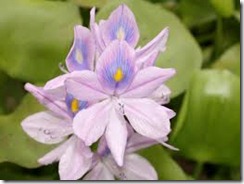Water hyacinths are one of the easiest to care for aquatic plants. They thrive in any body of fresh water and are hardy to 40 degrees F. In fact they are so indestructible they are classified as noxious weeds in many southern states, and it is illegal to import them to or export them from these states. Water hyacinths reproduce rapidly from both stolons and seeds. One water hyacinth plant can quickly become several hundred plants. Check with your local extension office to see if water hyacinths are legal in your state.
Caring for Water Hyacinths
-
Water hyacinths are a "low profile" aquatic plant. The plants float on top of the water and the leaves and flowers are only 12 to 18 inches tall. The air filled stems act as flotation devices for the hollow leaves (the leaves actually look like puffy green pillows) and the lavender-to-light-blue flowers.
Before you add new water hyacinth plants to your pond, remove all dead or broken leaves and cut the roots back to 2 inches long. Doing this will stimulate new growth.
Water hyacinth roots do not need to be in contact with the pond bottom for the plant to flourish. They float in the water below the plant and provide shelter for small fish and fish and insect eggs. In shallow water, hyacinths may take root in the soil at the bottom. They actually reproduce faster and grow larger when this happens. Older roots are black with hairy filaments, and younger roots are thin and white. When cutting back roots, cut back the older roots first.
Water Hyacinths in Your Pond
-
Water hyacinths form dense mats on the top of ponds, providing shelter and food for fish and insects. Allow your water hyacinths to spread until they cover approximately one-third of the surface of the pond. This coverage provides optimum habitat for your fish and enough plants to keep the water clear of fish waste and algae. Too many water hyacinths in your pond will result in the death of other desirable pond plants as they will not be able to compete with the hyacinths.
If your pond becomes overrun with water hyacinths, use a pond skimmer to remove excess plants. Spread the discarded plants in a sunny spot and allow them to dry out. Compost the now dried plants. Doing this ensures that discarded plants will not be accidentally carried into native waterways.
Always remove dead plants promptly as decomposing water hyacinths become slimy and can make a mess of your pond and your pond filters.
Water hyacinths form clumps with daughter plants being produced on the ends of runners or stolons. If hyacinth clumps become too large, separate the daughter plants from the mother plants by cutting the runners between plants. It doesn’t matter where you make the cuts on the runners as long as the new plants have roots.
Water hyacinths improve water clarity and quality in one growing season by limiting algae growth and removing excess organic matter in the water including fish waste, nitrogen and heavy metals. Do not use algae killers or chemicals that remove heavy metals from pond water as these will kill the plants. Add the hyacinths as usual, and the algae will start to die as they are deprived of sunlight and nutrients. If your pond is overgrown with algae, use an appropriate algae killer, wait at least four weeks and then add water hyacinths.
If your water hyacinth leaves start to yellow in mid summer, use a fish-safe fertilizer at half strength every other week until you see new growth and yellowing leaves begin turning green.
Winter Care
-
Water hyacinths will not survive the winter in areas where temperatures routinely fall below zero. You can, however, overwinter water hyacinths in aquariums. You can add a few plants to an existing fresh-water aquarium or set up an aquarium specifically for the water hyacinths.
Any size aquarium works as long as it holds at least 6 inches of water, but it’s best to keep water levels between 6 and 18 inches. Add several inches of soil from your pond to the bottom of the aquarium and use a tank topper with a florescent light. Water hyacinths should receive a minimum of six hours of light a day, although 12 to 14 hours are best.
In the spring, after all danger of frost has passed, simply place the plants back in your pond.


Deprecated: strpos(): Passing null to parameter #1 ($haystack) of type string is deprecated in /home/agriviek8Qv/agriviet.net/public_html/wp-includes/comment-template.php on line 2522